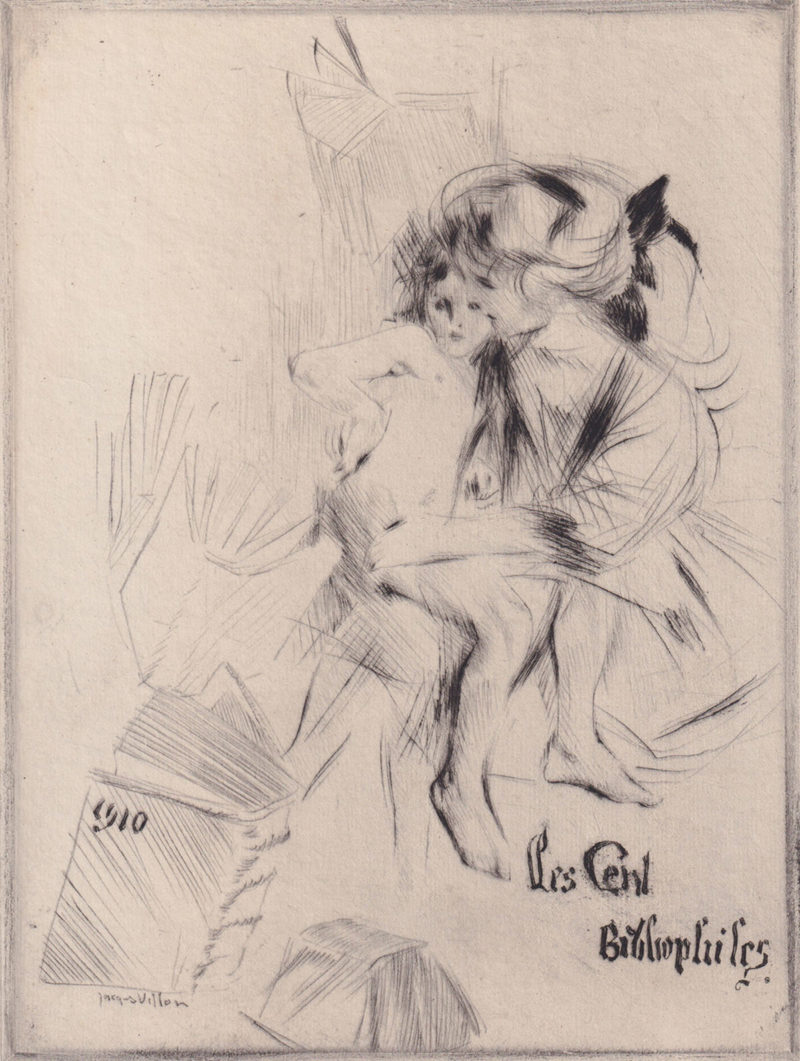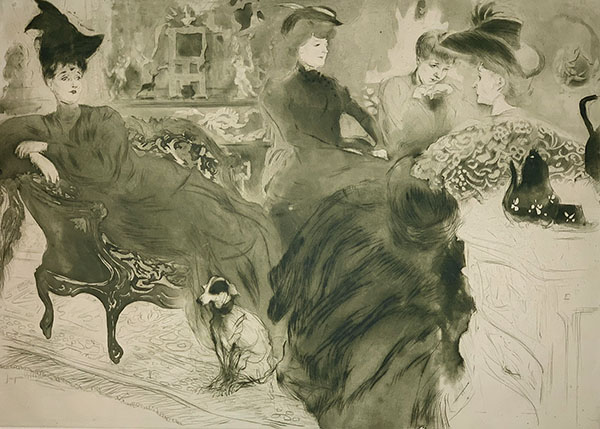Villon, Jacques
1875 – 1963
French
One might say that Jacques Villon was genetically pre-disposed to become an artist! Although his father was a lawyer, his maternal grandfather was a shipbroker with a fine reputation as an amateur painter and engraver. Jacques (or Gaston, as he was named by his parents) was the oldest of 6 children in the Duchamp family, 4 of whom achieved varying degrees of fame and fortune as artists – Marcel Duchamp, arguably the most influential artist of the 20th Century, Raymond Duchamp-Villon, Suzanne Duchamp-Roger and himself.
Despite this familial tendency, Jacques initially pursued his father’s profession and studied law at the University of Paris. He completed his schooling and accepted a position with a lawyer in Rouen. This was a short-lived situation and within a year he was back in Paris and enrolled at the Ecole des Beaux Arts. He became enamored of the print process and focused his attention on engraving, lithographs and aquatints.
It was at this point in his life that he adopted the pseudonym “Jacques Villon”. Jacques in homage to the title character of Alphonse Daudet’s novel “Jack” (1876) and Villon as a tribute to his favorite poet François Villon who lived in the 15th Century.
Jacques Villon became a true working artist. While he continually strove to improve his painting technique, he supported himself by selling illustrations to such magazines as “Chat Noir”, “Rire”, “L’Assiette au Beurre” and “Courier Français”. He also made posters for the cabarets in Montmartre.
By the turn of the century he had established himself as a serious artist and print-maker. Between 1899 and 1911 Jacques Villon created a vast number of beautiful etchings, engravings and aquatints. His style evolved from the Neo-Impressionist influence of Degas and his friends Steinlen and Toulouse-Lautrec to the fashionable elegance of Paul Helleu.
He eventually took on a studio in the town of Puteaux that developed into a gathering place for his peers – artists such as Picabia, Leger and Gleizes. It was here, in around 1911, that he explored the principles of Cubism and established the “Section d’Or” group. He maintained this studio for the rest of his life.
Villon was now moving toward a much more Modernist style of art. He participated in the famous Armory Show in New York of 1913 – the same show where his brother Marcel Duchamp caused such a sensation with “Nude Descending a Staircase”. He was recruited into the French army during WWI and fought in the Somme and Champagne. His service earned him the Croix de Guerre and the Légion d’Honneur but he also lost his brother Raymond who was killed in battle.
The post-war period was difficult for him financially and he augmented his income by creating a series of engravings reproducing the paintings of Manet, Cézanne, Matisse, Bonnard and others. Finally, in the 1930s he was able to pursue his own painting and exploration of the Abstraction Movement. During the German Occupation of France, Jacques Villon took refuge in the Tarn and continued to work there. After the Liberation he returned to his studio and eventually achieved a certain degree of regard and success with both painting and printmaking in his now-established geometric style.
The catalogue raisonné of the print œuvre of Jacques Villon is a fascinating study in evolving styles and principals. From the elegant etchings of Belle Epoque ladies to the pyramid theories of Cubism, Jacques Villon mastered them all. He was not afraid to explore new ideas or to change with the times. It is this command of so many different artistic expressions that has won him such esteem among print collectors everywhere.
-

Villon, Jacques
(1875 - 1963) French$750.
“Les Cent Bibliophiles (G&P 250)”, 1910
Etching and drypoint
Edition of 100
9 ½" x 7"
Signed in plate -

Villon, Jacques
(1875 - 1963) FrenchSOLD
“Le Potin (G & P 96)”, 1905
Drypoint and aquatint printed in greenish ink
3rd State/3
Edition of 50
16 ¼" x 22 ½"
The sitter is Yvonne Bon, Madame Raymond Duchamp, the artist's sister-in-law
Blind stamped "Ed. Sagot Paris" in margin
Signed in plate
Signed and annotated "Nº 35" in pencil in margin
